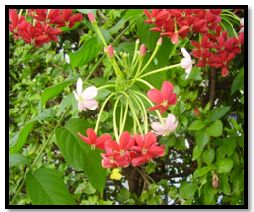
Botanical Name:- Combretum indicum (L.) DeFilipps
Common Name:– Madhu Malti
Classification:-
Kingdom-Plantae
Division -Spermatophyta
Class-Dicotyledonae
Order-Myrtales
Family-Combretaceae
Genus-Combretum
Species-C. indicum
Characteristics Of Combretaceae Family:-
The Combretaceae are trees, shrubs, and lianas comprising about 20 genera and 600 species. The leaves are simple, alternate or opposite, entire; stipules small or absent. The flowers are bisexual or sometimes unisexual, usually actinomorphic. The perianth arises from near the summit of a tubular epigynous zone; calyx of usually 4 or 5 distinct to slightly connate sepals; corolla commonly of 4 or 5 distinct petals, occasionally absent. The androecium of 4-10 stamens is adnate to the epigynous zone, commonly in two cycles, often strongly exserted. The gynoecium is a single compound pistil of 2-5 carpels; style and stigma 1; ovary inferior, with 1 locule, apical ovules pendulous on long funiculi. The nectary is usually a disk (often hairy) above the ovary. The fruit is 1-seeded, often a flattened, ribbed, or winged drupe.
Habitat :- Rain forests, hedges, mountains, riversides and wasteland.
Distribution:- Philippines, India and Malaysia.
Status:- Exotic
Plant Description:- Twining liana, attaining 6 m in length. Stem much branched from the base; branches cylindrical, somewhat compressed in the area of the nodes, glabrous , usually with the pith hollow; adult stems deciduous, with 3 persistent spines at the nodes.
Leaves opposite or subopposite, elliptical, oblong or lanceolate, chartaceous, the apex acuminate, the base rounded, the margins entire; upper surface glabrous, with a prominent mid vein; lower surface ferruginous-tomentulose or puberulous, with prominent venation. Flowers sessile or sub-sessile, in terminal spikes or racemes on short lateral branches.
Hypanthium green, tubular, pubescent; sepals green, triangular, petals 5, oblong or oblanceolate, pink, turning red when mature; stamens exserted, the filaments unequal; disc absent.
Uses Of Plants:-
Decoctions of the root, seed or fruit can be used as antihelmintic to expel worms.
Fruit decoction can also be used for gargling.
Leaves can be used to relieve pain caused by fever.
The roots are used to treat rheumatism.
Flowers are used to relieve headache.